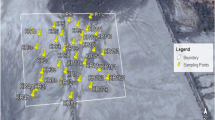Abstract
This paper concludes that a 70 wt% salt/30 wt% bentonite mixture is preferable to pure crshed salt as backfill for disposal rooms in the Waste Isolation Pilot Plant. The performance of two backfill materials is examined with regard to various selection crteria related to compliance with the transuranic radioactive waste standard 40 CFR 191, Subpart B, such as the need for low liquid permeability after closure, chemical stability, strength, ease of emplacement, and sorption potential for brine and radionuclides. Both salt and salt/bentonite are expected to consolidate to a final state of permeability ≤ 10-18 m2, which is adequate for satisfying government regulations for nuclear repositories. The real advantage of the salt/bentonite backfill depends, therefore, on bentonite’s potential for sorbing brine and radionuclides. Estimates of the impact of these properties on backfill performance are presented.
Similar content being viewed by others
References
B.M. Butcher, C.F. Novak, and J. Jercinovic, The Advantages of a Salt/Bentonite Backfill for Waste Isolation Pilot Plant Disposal Rooms, SAND90-3074 (Sandia National Laboratories, Albuquerque, NM, 1991).
A.R. Lappin, R.L. Hunter, D.P. Garber, and P.B. Davies, eds., Systems Analysis, Long-Term Radionuclide Transport, and Dose Assessments, Waste Isolation Pilot Plant (WIPP). Southeastern New Mexico: March 1989, SAND89-0462 (Sandia National Laboratories, Albuquerque, NM, 1989).
T.W. Pfeifle. Consolidation. Permeability, and Strength of Crushed Salt/Bentonite Mixtures With Application to the WIPP, SAND90-7009 (Sandia National Laboratories, Albuquerque, NM, 1991).
C.M. Stone, R.D. Krieg, and Z.E. Beisinger, SANCHQ, A Finite Element Computer Program for the Quasistatic. Large Deformation. Inelastic Response of Two-Dimensional Solids, SAND84-2618 (Sandia National Laboratories Report, Albuquerque, NM, 1985).
J.R. Weatherby and W.T. Brown, in A Summary of the Models Used for the Mechanical Response of Disposal Rooms in the Waste Isolation Pilot Plant with Regard to Compliance with 40 CFR 191. Subpart B, B.M. Butcher and F.T. Mendenhall, SAND92-0427 (Sandia National Laboratories, Albuquerque, NM, 1993), pp. A–199 through A-222.
D.J. Holcomb, and M. Shields, Hydrostatic Creep Consolidation of Crushed Salt With Added Water, SAND87-1990 (Sandia National Laboratories, Albuquerque, NM, 1987).
J.C. Stormont, Preliminary Seal Design Evaluation for the Waste Isolation Pilot Plant, SAND87-3083 (Sandia National Laboratories, Albuquerque, NM, 1988).
G. Kappei, Geotechnical Investigations on Backfill Materials in the Asse Salt Mine, GSF-T-250 (Gesellschaft für Strahlen-und Umweltforschung München, Brunswick, F.R. Germany, 1987).
T.W. Pfeifle and N.S. Brodsky, Swelling Pressure, Water Uptake, and Permeability of 70/30 Crushed Salt/Bentonite, SAND91-7070 (Sandia National Laboratories, Albuquerque, NM, 1991).
J.L. Krumhansl, Observations Regarding the Stability of Bentonite Backfill in a High-Level Waste (HLW) Repository in Rock Salt, SAND83-1293 (Sandia National Laboratories, Albuquerque, NM, 1984).
L.D. Tyler, R.V. Matalucci, M.A. Molecke, D.E. Munson, E.J. Nowak, and J.C. Stormont, Summary Report for the WIPP Technology Development Program for Isolation of Radioactive Waste, SAND88-0844 (Sandia National Laboratories, Albuquerque, NM, 1988).
R. Pusch and O. Karnland, Aspects of the Physical State of Smectite-Adsorbed Water. SKB Technical Report 86-25 (Srensk Kärnbränsleförsörjning A.B., Stockholm, Sweden, 1986).
C.F. Novak, in The Advantages of a Salt/Bentonite Backfill for Waste Isolation Pilot Plant Disposal Rooms, B.M. Butcher, C.F. Novak, and M. Jercinovic, SAND90-3074 (Sandia National Laboratories, Albuquerque, NM, 1991), pp. B–2 through B-7.
Author information
Authors and Affiliations
Rights and permissions
About this article
Cite this article
Butcher, B.M. The Advantages of a Salt/Bentonite Backfill for Waste Isolation Pilot Plant Disposal Rooms. MRS Online Proceedings Library 333, 911–917 (1993). https://doi.org/10.1557/PROC-333-911
Published:
Issue Date:
DOI: https://doi.org/10.1557/PROC-333-911




